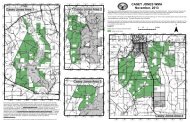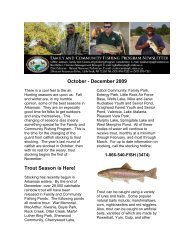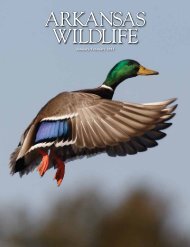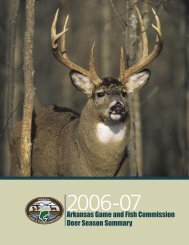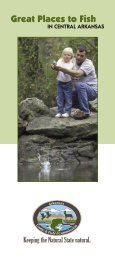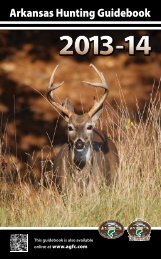View Article - Arkansas Game and Fish Commission
View Article - Arkansas Game and Fish Commission
View Article - Arkansas Game and Fish Commission
Create successful ePaper yourself
Turn your PDF publications into a flip-book with our unique Google optimized e-Paper software.
Deer were so concentrated during the floodsthat they ate everything in sight, including treebark. Photo by Dick Baxter.Soybean fields were at a particularlyvulnerable stage when the deer moved in.Photo by Dick Baxter.Firecracker rope was just one of thenoisemakers wildlife biologists used to keepdeer off farmers’ fields. AGFC photo.Devices called butane cannons, which are typically used to scarebirds off crops <strong>and</strong> fish farms, quickly became ineffective. The cannonsare set to go off at regular intervals but deer soon ignored therepetitive, low-pitched boom.Another option was firecracker ropes, long str<strong>and</strong>s of slowburningfuse that have high-pitched firecrackers placed at r<strong>and</strong>omspaces along the length. The ropes can be modified to fire a burst offirecrackers or fire singles at irregular intervals.“Firecracker ropes were much more effective,” Baxter said. “Theyreally do sound like someone firing a rifle, compared to the butanecannons.”The AGFC was able to issue firecracker rope to farmers duringfloods in 2009, but recent federal regulations require anyoneh<strong>and</strong>ling firecracker rope to be a member of a government agencyor to hold a license from the Bureau of Alcohol, Tobacco, Firearms<strong>and</strong> Explosives.“Instead of just h<strong>and</strong>ing them out to farmers in need, wildlifebiologists <strong>and</strong> technicians spent hundreds of man hours stringingup firecrackers <strong>and</strong> making sure they stayed lit,” Baxter said.During the floods, the AGFC Wildlife Management Bureau alsodeveloped “scareboxes,” <strong>and</strong> tested them on some properties. Thesedevices were an MP3 player, speakers <strong>and</strong> a battery, housed in acooler to protect the electronics from the elements.“We had those things playing everything from sirens <strong>and</strong>gunshot sounds to elephants trumpeting,” Baxter said. “They weredownright obnoxious <strong>and</strong> they worked pretty well.”Commercial versions scareboxes cost about $1,500.“Our version cost less than $300 a piece, <strong>and</strong> can probably besomething farmers can do on their own in the future, Baxter said.”A h<strong>and</strong>ful of shoot-to-kill permits was issued after every othermeans of scare tactic was employed, but very few deer were killed,compared to the typical fall harvest from the same area.“Killing the deer was an absolute last resort,” Baxter said. “Mostfarmers were very reluctant to do it because they hunt those samedeer in the fall or lease their property to hunters. But their cropsare their livelihood, <strong>and</strong> they had to do something to protect theirinvestment.”HomebodiesHunters who have property in the flooded areas can still lookforward to a good year in their old stomping grounds. According toBaxter, the movement to the fields was temporary <strong>and</strong> deer shouldbe back in the river bottoms by the beginning of the deer season.“Most of our studies show that when floodwaters begin torecede, deer, especially does, will almost immediately move back totheir old habitat,” said Baxter. “Bucks will w<strong>and</strong>er a bit more untillater in the season, but it’s not like they find the new food source<strong>and</strong> stay there forever.”Baxter does warn that hunters may see a small decrease in thenumber of fawns this year, because the floods hit during the beginningof the fawning season.“It actually looks more promising than we’d hoped,” said Baxter.“We’re still seeing some fawns in the area. Deer along the MississippiRiver have a later breeding season than surrounding areas. Biologistsbelieve it’s an adaptation those deer have made to withst<strong>and</strong>floods just like this.” AWDeer weren’t the only animals seeking cover from the flood. The area also is host tothous<strong>and</strong>s of feral pigs, which are extremely destructive to the habitat, farmer’s crops <strong>and</strong> theriver levee that was already stressed. As the water pushed the pigs into the open, the AGFC wasable to take advantage of the situation.“We heard about some large groups of hogs coming to the fields, <strong>and</strong> realized we had anopportunity to put a dent in the population,” said Captain Stephanie Weatherington, AGFCdisaster response coordinator. “Our officers were instructed to shoot any pig they could as theywere performing their other duties. We had to protect the levee from further damage.”SEPTEMBER • OCTOBER 2011 ARKANSAS WILDLIFE9
Lostin the MarshDuck Season Overshadows Other Migrating BirdsBy R<strong>and</strong>y ZellersA successful day inthe marsh isn’t alwaysmeasured in waterfowl.Photo by David Krementz/USGS <strong>Arkansas</strong>Cooperative <strong>Fish</strong> <strong>and</strong>Wildlife Research Unit.Hundreds of thous<strong>and</strong>s of rails, woodcocks <strong>and</strong> snipe arrive in <strong>Arkansas</strong> each year, before the first wavesof mallards begin descending. They can be hunted after duck season closes but hardly any hunters seem tocare.About 1,100 <strong>Arkansas</strong> hunters admitted to hunting early migratory birds (called webless migrants by theU.S. <strong>Fish</strong> <strong>and</strong> Wildlife Service) during the 2009-10 waterfowl season, according to the Harvest InformationProgram survey for <strong>Arkansas</strong>. That’s about 2 percent of hunters who pursue ducks in similar habitat.“Those numbers are much more general than we can give for dove or duck hunters, simply because there’ssuch low participation,” said Luke Naylor, <strong>Arkansas</strong> <strong>Game</strong> <strong>and</strong> <strong>Fish</strong> <strong>Commission</strong> waterfowl programcoordinator. “The survey is based to give national numbers <strong>and</strong> doesn’t give such low numbers with extremeaccuracy.”Nontraditional ValuesNaylor says he thinks the lack of participation during the early season may have a lot to do with shifts intraditional hunting.“Hunters go out for the dove opener, then maybe go for an early teal hunt, then they head to the deerwoods,” Naylor said. “Duck leases aren’t flooded until later in the season when the ducks begin to arrive, sothere’s not as much habitat available to hunt early in the year.”Naylor’s even a bit confused about why more people don’t pursue snipe, which flock to <strong>Arkansas</strong> duringthe tail end of duck season.“The habitat is there, the snipe are there <strong>and</strong> the hunters are there, but few seem to take advantage of theopportunity.“I’ve been on hunts in shallowly flooded rice fields where I could tell that it just wasn’t going to happen.16ARKANSAS WILDLIFE SEPTEMBER • OCTOBER 2011
The snipe were buzzing our layout blinds,so we finally got up <strong>and</strong> started huntingfor them. The day changed from a horriblegoose hunt to a decent snipe hunt, <strong>and</strong> webrought home a few birds to cook.”Elite No MoreDr. David Krementz is a wildlifebiologist for the U.S. Geological Survey<strong>Arkansas</strong> Cooperative <strong>Fish</strong> <strong>and</strong> WildlifeResearch Unit, <strong>and</strong> avid hunter of earlymigrants. According to him, snipe,woodcock, rails <strong>and</strong> gallinules make up thebottom rung of the migratory bird harvest,but that wasn’t always the case.“Snipe hunting actually used to be anelite hunter’s sport,” Krementz said. “Therewas a large contingent of snipe hunters aslittle as 50 years ago.”The largest blow to snipe hunting camewhen the population crashed <strong>and</strong> theseason had to be closed for a decade. Whenit reopened, many hunters had forgottensnipe <strong>and</strong> had taken to other species, suchas mallards <strong>and</strong> pintails.“The sport never regained its statureafter the closure. It’s a shame, becauseit’s as addictive as any type of hunting Iknow.”Arrival TimeWaterfowl hunters can mix weblessmigratory bird hunts into their seasonsby following migration timing. Krementzsuggests hunters focus on soras <strong>and</strong>Virginia rails during September <strong>and</strong>October, switch to woodcock duringNovember <strong>and</strong> December, then finish theyear with snipe in late January <strong>and</strong> huntuntil mid-February, after duck seasonshave closed.“I often hunt for teal in the morningsof early teal season, then go after soras<strong>and</strong> rails. During duck season, I’ll huntmallards in the morning the same way,then switch to snipe once the ducks havestopped flying.”in knee-high cover with patches of water<strong>and</strong> open marsh nearby. Moist-soil unitsmanaged for ducks <strong>and</strong> other waterfowl areideal. Soras <strong>and</strong> Virginia rails typically runto the edge where dense weeds <strong>and</strong> brushborder open marsh.“They’ll hold there until they have noother option than to fly,” Krementz said.“When they finally do flush, you can havefive or six birds in the air at once, creatingan awesome shooting opportunity.“It’s a great hunt for kids. The weatherisn’t as bitter as during duck season, thebirds are easy to hit, <strong>and</strong> everyone can talk<strong>and</strong> have fun watching the dogs work.”Sniping for SportA snipe hunt can be a humbling experience.They’re easy to find in <strong>Arkansas</strong>,which has as many wintering snipe as anystate in the South. But they’re extremelyhard to hit.Krementz hunts snipe the same wayhe chases rails, but sticks to more openhabitats. Flooded rice fields often canbe the ticket, especially those with largepatches of open water used by duck <strong>and</strong>goose hunters. Mud flats also tend tohold large concentrations of snipe duringwinter.“You really want close-working flushingdogs for snipe, because they’ll flush quickly<strong>and</strong> give you a small target.”Upl<strong>and</strong> OutingIf one early migratory bird goes againstthe grain, it’s the woodcock. Appearinglike a misshapen snipe, the woodcock ismuch more at home in dense undergrowthof upl<strong>and</strong> forests than marshes.“Think of a dense, 2- to 3-year-oldclearcut where white-tailed deer beddown <strong>and</strong> you have the perfect woodcockhabitat,” Krementz said. “I even talk torabbit hunters <strong>and</strong> deer hunters whenscouting an area to see if they’ve seenwoodcock where they’re hunting.”Hunters generally associate thesebirds with the soft soils of southeastern<strong>Arkansas</strong>’s Mississippi Delta, <strong>and</strong> quite afew live in that region, but more are foundin the southwestern corner of the state,thanks to increased timber practices.“<strong>Arkansas</strong> has a lot of woodcockRail RallyKrementz likens a rail hunt to a pheasantdrive set in the swamp. He typically wantsthree to five hunters walking in hip boots<strong>and</strong> a flushing dog or two to push the birdsto the edge of the habitat. The birds restMost snipe are taken as targets of opportunity by duck hunters late in the season. Photo by DavidKrementz/USGS <strong>Arkansas</strong> Cooperative <strong>Fish</strong> <strong>and</strong> Wildlife Research Unit.SEPTEMBER • OCTOBER 2011ARKANSAS WILDLIFE17
Hundreds of thous<strong>and</strong>s of rails, woodcocks <strong>and</strong> snipe arrivein <strong>Arkansas</strong> each year, before the first waves of mallards begindescending. They can be hunted after duck season closes buthardly any hunters seem to care.About 1,100 <strong>Arkansas</strong> hunters admitted to hunting early migratorybirds (called webless migrants by the U.S. <strong>Fish</strong> <strong>and</strong> WildlifeService) during the 2009-10 waterfowl season, according to theHarvest Information Program survey for <strong>Arkansas</strong>. That’s about 2percent of hunters who pursue ducks in similar habitat.“Those numbers are much more general than we can give fordove or duck hunters, simply because there’s such low participation,”said Luke Naylor, <strong>Arkansas</strong> <strong>Game</strong> <strong>and</strong> <strong>Fish</strong> <strong>Commission</strong>waterfowl program coordinator. “The survey is based to givenational numbers <strong>and</strong> doesn’t give such low numbers withextreme accuracy.”Sora hunting during early season is an excellent opportunity to workretrievers. Photo by Craig Endicott.Nontraditional ValuesNaylor says he thinks the lack of participation during the earlyseason may have a lot to do with shifts in traditional hunting.“Hunters go out for the dove opener, then maybe go for an earlyteal hunt, then they head to the deer woods,” Naylor said. “Duckleases aren’t flooded until later in the season when the ducks beginto arrive, so there’s not as AW much habitat available to hunt early inthe year.”18Although the breed has been relegatedto lapdog duty by many owners, cockerspaniels owe their bloodline to thewoodcock.According to the American KennelClub, cocker spaniels originally werehunting dogs, flushing grouse <strong>and</strong>woodcock from dense cover. The name“cocker” is directly attributed to theirusefulness in hunting woodcock.Few breeders raise cocker spaniels fortheir original sporting purpose, preferringthe larger Boykin <strong>and</strong> springer spaniels.No registered cocker spaniel breeders in<strong>Arkansas</strong> promote their dogs for hunting,but hunters interested in a cocker can findone with a little luck <strong>and</strong> a long drive.Curtis Rogers of Warrior Spring Ranchin Coleman, Texas, raises hunting cockerspaniels, <strong>and</strong> proclaims there is no betterdog for flushing birds in dense cover.“If you’re looking for a spaniel, be sureto look at dogs from the English bloodline,” Rogers said. “Most American cockerswill have long hair <strong>and</strong> stubby legs, <strong>and</strong> aremore show dogs than hunters.”Rogers says cockers are even adept atretrieving downed birds, including dove,ducks <strong>and</strong> upl<strong>and</strong> game birds.“They’ll even do water retrieves onducks as big as a mallard,” he said witha smile. “They may have to drag it onthe ground when they get it ashore, butthey’ll do everything in their power toplease you.”Rogers primarily hunts chukar <strong>and</strong>pheasant with his dogs, but has used themon their namesake woodcock.“I took one of my dogs on a guidedhunt for grouse <strong>and</strong> woodcock twoyears ago. We flushed six grouse <strong>and</strong> sixwoodcock during the day-<strong>and</strong>-a-halfhunt. The guide was using a springerspaniel <strong>and</strong> an Irish setter, but was soimpressed by my dog, he bought a puppyfrom me by the end of the hunt.”ARKANSAS WILDLIFE SEPTEMBER • OCTOBER 2011Cocker spaniels love to please their owner,which makes them excellent huntingcompanions. Photo courtesy of Curtis Rogers.
Wing Shooting’sLeastWantedIn the 1940s, woodcock <strong>and</strong> snipe held the attention of manyhunters willing to brave the marsh with oilskin waders <strong>and</strong> side-bysideshotguns. European varieties of these birds still are revered bywing shooting clubs in France <strong>and</strong> Irel<strong>and</strong>.With the increase in ducks <strong>and</strong> duck hunters, marsh birds havebeen ignored to the point that few outdoors enthusiasts canidentify them. Here’s a lineup of these forgotten species to helpwould-be hunters find their targets.RailsA few species of rail live in or migratethrough <strong>Arkansas</strong>, but hunters havetwo they can legally take – Virginia rail<strong>and</strong> sora. Both species are slightly largerthan a dove, about 8-10 inches frombeak to tail, <strong>and</strong> about 4 ounces. Theyhave compact bodies with long, strongVirginia Rail. Photo by legs they use to step through the marsh,Michael J. Budd/USGS<strong>Arkansas</strong> Cooperative <strong>Fish</strong> looking for aquatic plant seeds, small<strong>and</strong> Wildlife Research Unit. insects <strong>and</strong> crustaceans.The easiest way to distinguish the twospecies is by their beaks. The sora has acompact, bright yellow beak <strong>and</strong> a blackpatch of feathers at the front of the head;the Virginia rail sports a long, curved,orange beak to probe a bit deeper intothe marsh.Rails typically run to thickmarsh grasses when threatened, <strong>and</strong>occasionally swim to avoid predators,Sora. Photo by Joy Viola, but both species take flight when theyNortheastern University, run out of cover, offering a shootingBugwood.org.experience similar to a pheasant drive.Hunters searching for rails should be familiar with the king rail, aspecies in decline <strong>and</strong> off-limits to hunters. Adult king rails are almosttwice as large as soras <strong>and</strong> Virginia rails, rivaling the dimensions ofa teal. They are camouflaged in the same brown plumage as Virginiarails with a curved, orange beak.Woodcock. Photo by RickyLayson Photography,Bugwood.org.WoodcockThe woodcock’s appearance can besummed up in one word – peculiar. Thebulbous head is seemingly attached toa small, quail-like body without a neck.The eyes look a bit out of place, restingcloser to the top of the head than mostbirds’ eyes. They use their abnormallylong, slender beak to probe soft soils forearthworms, their favorite food.Woodcock are much more in tune with upl<strong>and</strong> habitats than otherearly migrants. Hunters pursuing these odd-looking birds should payclose attention to thick, overgrown areas typical of rabbit <strong>and</strong> whitetaileddeer bedding cover. Areas that have been clearcut <strong>and</strong> allowed togrow dense with briars <strong>and</strong> chest-high vegetation are top spots to startthe search.SnipeWilson’s snipe are plentiful in<strong>Arkansas</strong> during their migration inthe latter half of duck season. Theircryptic, brown colors make themnearly impossible to spot until theyflush. They sport a long beak, similarto the woodcock, but don’t share thewoodcock’s odd eye placement.Snipe tend to stick to marshes <strong>and</strong> open wetl<strong>and</strong>s with small clumpsof cover scattered throughout. Harvested rice fields <strong>and</strong> moist-soilunits are particularly attractive to snipe, especially when patches of dryl<strong>and</strong> create irregular edges between vegetation <strong>and</strong> water.No bird can compare to the snipe when it comes to avoiding theshot. Even veteran dove hunters will find the combination of a marshyfooting <strong>and</strong> the snipe’s erratic flight to be too much to h<strong>and</strong>le at times.According to the Online Etymology Dictionary, “sniper” originallywas used by British soldiers stationed in India to praise shooting abilitybecause only the finest shots could hit snipe as they zigzagged away.Gallinules <strong>and</strong> MoorhensThe most adept swimmers of thewebless migratory birds, gallinules <strong>and</strong>moorhens resemble small chickenswith extremely long, bright yellow legs.Both species have triangular red beakswith yellow tips. Purple gallinules havestriking purple <strong>and</strong> green iridescentplumage; moorhens are covered in slick,black feathers with small white stripesunderneath the wings. Gallinules <strong>and</strong>moorhens usually fly to South Americain September, <strong>and</strong> are found along theLouisiana border in <strong>Arkansas</strong> for a shorttime during the hunting season.Moorhens <strong>and</strong> gallinules are morecomfortable with open water than therest of the early migratory species, <strong>and</strong>are commonly found at the shoreline,feeding on the seeds of aquatic grasses,snails <strong>and</strong> small crustaceans. Althoughthey are awkward fliers, these rarelypursued marsh birds can distribute theirweight over their long toes <strong>and</strong> walkeffortlessly across lily pads <strong>and</strong> otherfloating vegetation.SEPTEMBER • OCTOBER 2011Snipe. Photo by AlfredViola, NortheasternUniversity, Bugwood.org.Moorhen. Photos byJoy <strong>and</strong> Alfred Viola,Northeastern University,Bugwood.org.Gallinulle. Photos byJoy <strong>and</strong> Alfred Viola,Northeastern University,Bugwood.org.ARKANSAS WILDLIFE19




